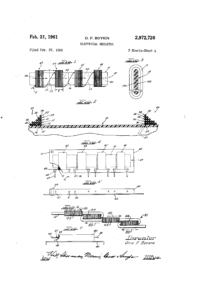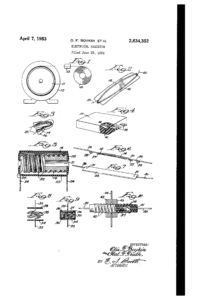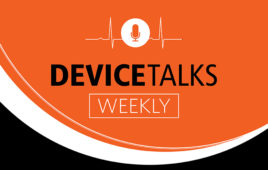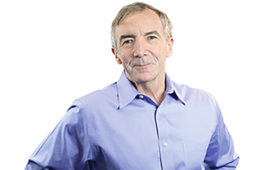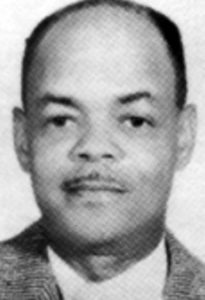
[Image from the National Inventors Hall of Fame]
An African-American inventor and engineer, Otis Boykin had a special interest in resistors. His mother died from heart failure when he was 1 year old. Thirty-one years later, he filed a patent for a resistor that paved the way for his most notable invention, the pacemaker control unit.
While working at Lisle, Ill.-based CTS Corp., Boykin filed a patent (U.S. Patent No. 2972726A) for a high-precision, wire-type electrical resistor that could be readily adapted to different space requirements and configurations. According to the patent, the resistor was designed to combine minimum inductive properties with minimum capacitive effects. It could also provide tolerances as low as required and could withstand “relatively great accelerations and shocks and great temperature changes” without breaking the fine resistance wire or causing other detrimental effects.
In the patent filing, which lists CTS as the assignee, Boykin said the resistor was made of lengths of resistance wire between 0.0006 in. and 0.010 in. in diameter and had resistance values of 0.05 ohm to several megohms. The patent also says the resistor could be made cheaply and quickly without wire strain. Most importantly, the high-precision, wire-type electrical resistor could enable pacemakers to have a time base — the repeated sending of uniform signals — at a much smaller scale.
Pacemakers are small devices that help the heart beat regularly by delivering a small electric stimulation that controls the heartbeat. The control units help identify the number of pulses per minute needed for each individual patient and the pulses become the number of beats per minute for the paced heart.
“Essentially, it helps to control a patient’s heart rate,” Gabriel Mouchawar, divisional VP of product development at Abbott, told Medical Design & Outsourcing. “The invention of the resistor and later the capacitor was essential in setting the time base for electronic devices, so the work of Otis Boykin was incredibly important to advance the technology.”
The earliest pacemaker devices were external and needed to be plugged into a wall while patients used them. By 1957, Medtronic founder Earl Bakken, an electrical engineer by trade, developed the first battery-operated wearable pacemaker. Dr. Walton Lillehei, a pioneer of open-heart surgery, asked Bakken to build the pacemaker after a child who was connected to an AC-powered pacemaker died during a power failure.The first pacemaker implantation surgery took place in Sweden in 1958. Innovations continued, many of them enabled by Boykin’s contribution.
“Pacemakers today are powerful devices with a number of benefits for patients. Many have computing power similar to early personal computers and can last more than 10 years on their internal battery,” Mouchawar said. “But all technology starts somewhere, and Otis Boykin’s work set the technology on a path that led us to where we find ourselves today.”
Boykin graduated from a Dallas high school as valedictorian in 1938. He went on to attend Fisk University and worked as a laboratory assistant in an aerospace lab, the National Inventors Hall of Fame reported. There, Boykin started to work on aircraft controls and various electronic resistors and became familiar with electrical components. He later moved to Chicago and worked in the P.J. Nilsen Research Lab where he eventually met Hal Fruth, with whom he would later start his Boykin-Fruth business, according to the Lemelson Program at the Massachusetts Institute of Technology.
In 1952, Boykin-Fruth filed a patent with the U.S. Patent and Trademark Office related to a non-adjustable metal resistor made of wire or ribbon that could be coiled woven or formed as grids arranged to reduce self-induction, capacitance or variation with frequency, according to the patent filing. It was the start to a line of as many as 27 electrical device patents and eventually the resistor that would become a part of the pacemaker’s control unit.
“Otis’s work was instrumental in making the components of the pacemaker longer-lasting and manufacturable at a lower cost, which in turn helped increase access to the therapy to improve patient care. For companies like Abbott, the devices we offer today stand on a foundation built by people like Otis who made a remarkable impact on the field,” Mouchawar said.
Abbott (St. Jude Medical), Boston Scientific and Medtronic lead the way in pacemaker development today. Abbott has a number of cardiac rhythm management devices in its portfolio, including pacemakers, insertable cardiac monitors, quadripolar LV leads and CRT-Ds. Medtronic has four pacemakers in its current offerings with seven others in its past and Boston Scientific has five of its own pacemakers on the market.
“Boykin’s work was critical to developing a pacemaker generator that was efficient, compact and resilient over time. Several decades of iteration on his foundational work have brought us rate-adaptive pacing, the ability to track the atrium and address complete heart block and rate responsiveness features that augment heart rate commensurate with physical activity,” a spokesperson at Boston Scientific told MDO.
Because of Boykin’s invention, companies like Boston Scientific have also been able to develop leadless pacemakers, which are less invasive and 90% smaller than transvenous pacemakers, according to the American College of Cardiology. While leadless pacemakers only provide single-chamber ventricular pacing and lack defibrillation capacity, they eliminate complications that arise with transvenous pacemakers and leads, including pocket infections, hematoma, lead dislodgment and lead fracture.Pacemakers are getting smaller and less invasive and the future of the device is on track to becoming even smaller with new power options and remote monitoring. Boston Scientific projects that there will be more opportunities in the future for modular rhythm management with multiple device communicating with one another. Pacemakers could also be implanted at different time intervals as a patient’s condition changes. Moreover, the company predicts that pacemakers could become energy-harvesting, meaning that instead of relying on batteries to power, they could use the motion of the heart or blood chemicals as a power source.
Mouchawar at Abbott thinks the next generation of pacemakers offered to patients will be smaller, last longer and offer new remote monitoring capabilities through Bluetooth connections to a patient’s smartphone. “How the devices deliver care will offer one set of advancement, while new ways for patients to stay connected to their hospital or clinic will offer another avenue for companies like Abbott to continue improving outcomes.”

